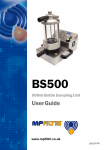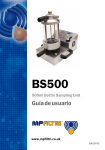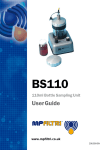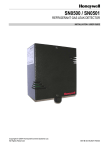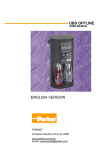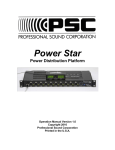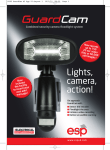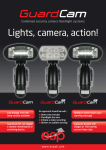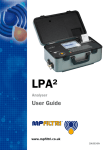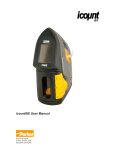Download BS500/User Guide
Transcript
BS500 500ml Bottle Sampling Unit User Guide www.mpfiltri.co.uk 200.307-EN Covers Model Numbers BS500 SAFETY WARNING Hydraulic systems contain dangerous fluids at high pressures and temperatures. Installation, servicing and adjustment is only to be performed by qualified personnel. Do not tamper with this device. Document Revision 1.0 Contents 1 Introduction 5 2 Scope of Supply 6 3 Specification 7 4 Preliminary operations 8 •Precautions 5 Fluid/Assembly Preparation and Analysis •Flushing and Flushing Fluids •Procedure •De-aeration 11 •Operating with contamination monitoring . . . 6 Information 17 •Warranty •Spare Product / Part Numbers 7 Fault Finding 18 Document Revision 1.0 1 Introduction The Bottle Sampler is an off-line unit designed to be used with LPA2 and CML2 for accurate contamination monitoring suitable for laboratory applications utilising mineral oil as the operating fluid. Please contact your local sales office for alternative fluid options. Benefits • Easy to use • Large sample volume sampling up to 500ml bottles • De-aeration facility Check that... • the operator has read this manual • all the accessories are present and correct • there is no damage to any of the components Introduction 5 2 Scope of Supply Each standard Bottle Sampler supplied consists of the following:• • • • • • 6 1 x 500ml Bottle Sampler, base unit and removable top chamber 1 x BS500 User guide 1 x 0.6m Minimess hose 3 x 200ml bottles 2 x 500ml bottles 1 x 12V DC power supply (Mascot 9887), with rated output of 12V DC, 3.33amp maximum current. DC connector is centre pin positive. Important: do not use the contamination monitoring product power supply with the 500ml bottle sampling unit, as it has an inadequate power rating Scope of Supply 3 Specification Power supply 12V DC power supply (Mascot 9887), with rated output of 12V DC, 3.33amp maximum current. Indicator Visiwink pressure indicator Fluid compatibility Mineral oil compatible - please contact sales team for queries about other fluids Hoses 600mm minimess hose Viscosity 400 cSt maximum fluid viscosity Ambient temperature -10°C Min to 80°C Max Working temperature 0°C Min to 40°C Max Dimensions 340mm(H) x 264mm(W) x 350mm(D) Weight 7kg As a policy of continual improvement, MP Filtri UK reserve the right to alter the specification without prior notice. Figure 1 Specification 7 4 Preliminary operations 4.1 Precautions 4.1.1 Internal Cleaning Take care when cleaning the transparent cylinder, areas around the seals and surrounding metal work. clean the Bottle Sampler with Acetone or similar solvents that are not compatible with the seals. The recommended cleaning fluid for internal flushing is listed on the website: www.mpfiltri.co.uk. Refer to key drawing on page 7. DO NOT 4.1.2 Pressurisation and Opening Always make sure that the top chamber is fully engaged before switching on the product. Always make sure to vent the product of pressure prior to opening or re-starting the pump (check visiwink). Warning: Turning on the pump with the unit pressurised can reduce the performance of the product and/or cause irreparable damage. 4.1.3 Bottle Cleanliness and Verification To reduce the risk of your sample container affecting the contamination reading of your fluid sample, where possible try to use bottles which have been cleaned and verified to the relevant ISO standards, these include but are not limited to DIN ISO 3722 - Hydraulic Fluid Power - Fluid Sample Containers - Qualifying & Controlling Cleaning Methods 8 Preliminary operations DIN ISO 5884 - Fluid systems and components - Methods for system sampling and measuring the solid particle contamination of hydraulic fluids US FED STD 209E Cleanroom Standards - Class 100,000 minimum ISO 14644-1 Cleanroom Standards - ISO 8 minimum How to clean and re-use your own bottles For definitive guidance on the cleaning and verification of glassware refer to ISO3722 and ISO5884. Below are some steps based on the above standards. For use with Hydrocarbon/Synthetic/Ester Fluid sampling 1. Fill the container with 50ml acetone, replace the cap, shake vigorously and drain to a waste container. 2. Fill to 50% of the container volume with 0.4μm filtered Iso-propyl alcohol. Replace cap, shake vigorously and drain to a waste connector. 3. Fill to 50% of the container volume with 0.4μm filtered Petroleum Ether. Replace cap, shake vigorously and drain to a waste connector. 4. Loosely replace the cap and do not remove until you are ready to take your next sample. (This allows any trace amounts of Petroleum Ether to evaporate from the bottle, and reduces the risk of any air-borne particles entering the container.) 5. Once complete, the fluid sample should be disposed of correctly and responsibly in line with local and international regulations. For use with Water Based/Off-shore Fluid sampling 1. Fill the container with 50ml Iso-propyl alcohol, replace the cap, shake vigorously and drain to a waste container. 2. Fill to 50% of the container volume with 0.4μm filtered De-ionised water. Replace cap, shake vigorously and drain to a waste connector. Preliminary operations 9 3. Fill to 50% of the container volume with 0.4μm filtered De-ionised water. Replace cap, shake vigorously and drain to a waste connector. 4. Loosely replace the cap and do not remove until you are ready to take your next sample. (This reduces the risk of any air-borne particles entering the container.) 5. Once complete, the fluid sample should be disposed of correctly and responsibly in line with local and international regulations. 4.1.4 Fluid Sampling / Hand Pump We always recommend using our hand pump, clean bottle and hose method which limits ingress of contamination. Using the hand pump means that the sample hose can be cleaned or replaced between samples, and the bottle always remains isolated from the surrounding environment. Hand pump and hose are available as spares via MP Filtri UK. Please note, only currently available for 100ml and 200ml size bottles. 10 Preliminary operations 5 Fluid/Assembly Preparation and Analysis 5.1 Flushing and Flushing Fluids Prior to performing a test on the contamination monitoring product with a bottle sampler both units should be flushed in series with a suitable fluid to remove any traces of previous samples. For guidance on flushing fluids see the document on the CD supplied with the contamination monitoring product. Important! Do NOT use acetone 1. 2. 3. 4. 5. Bottle sampler 600mm minimess hose Contamination monitoring product Waste hose Waste container Fluid/Assembly Preparation and Analysis 11 5.2 Procedure 1. Connect minimess hose to the contamination monitoring product. 2. Connect minimess hose (600mm) to the bottle sampling connection. 3. Connect waste fluid hose to contamination monitoring product (waste connector). 4. Insert waste fluid hose into the waste bottle provided. 5. Connect the power supply to bottle sampler, using power adaptor supplied. 6. Switch ON the contamination monitoring product. 7. Select Short Test Sampling option. 8. Enter test details, for more information refer to the contamination monitoring product user guide. 9. Remove the top chamber by rotating anti clockwise, and then lifting. 10. Place a bottle with minimum 200ml of flushing fluid onto the base unit. 11. Replace the top chamber. The silver spot on the top chamber should be aligned with the centre of the smallest groove. The top chamber can then be lowered and the top should be lined up with the silver line between the two lines on the base. 12. Turn the selector handle to Pressure, towards the red disc P. 13. Turn the top valve anti-clockwise to the open position, towards the P. 14. Switch on the BS500. 15. The pressure inside the chamber will slowly increase and the visiwink will turn red. 16. Once the BS500 stabillises, this takes about 30 seconds, press flush button on the contamination monitoring product. This is approximately 30 seconds after the unit is switched on. 12 Fluid/Assembly Preparation and Analysis 17. Press the start button on the contamination monitoring product once about half the fluid has flushed from the bottle. This will start a short test which will purge the contamination monitoring product. 18. Once the test is complete press the flush button until all the fluid has flushed through, if the fluid coming from the waste is clear the contamination monitoring product and bottle sampler are ready for testing. If the fluid is not clear repeat the flushing process. 19. Turn off the bottle sampler. 20. Turn the selector handle to Vacuum, towards the yellow disc with V. This will release the pressure in the chamber. 21. Select Triple or Bottle Test Sampling option on the contamination monitoring product. 22. Draw off a sample of oil (150 ml. minimum) from the system into the bottle provided. If this is impractical then use the hand pump, clean bottle and hose provided to draw off a sample of fluid. Note: Please ensure that the pump and hose are cleaned with an appropriate filtered solvent (i.e. Iso-propyl alcohol) prior to the sample being taken. Sample bottles and associated products are to be cleaned in accordance with the instructions on page 8. 5.3 De-aeration It is important when analysing samples for the particles to be evenly distributed within the sample volume. This is achieved by agitating the sample. This improves the accuracy of readings from the contamination monitoring products as particles do not settle in the bottom of the bottle due to gravity. This also causes aeration in the sample which can interfere with the sensitivity of the monitor. The bottle sampler creates a small vacuum within the chamber. Over a short period of time, depending on the viscosity, the air bubbles work their way out of the sample. Fluid/Assembly Preparation and Analysis 13 For full compliance please refer to standard BS11500:2008 23. Agitate sample for minimum 3 minutes, we would always recommend using a paint shaker, on the highest frequency, to agitate the sample. If a paint shaker is not available we would recommend 4 to 5 minutes by hand with random direction movements. 24. Remove the top chamber from the base of the bottle sampler. 25. Place the sample bottle into the bottle sampler. Note: Do NOT pour oil sample directly into the chamber. 26. Replace the top chamber. The silver spot on the top chamber should be aligned with the centre of the smallest groove. The top chamber can then be lowered and the top should be lined up with the silver line between the two lines on the base. 27. Screw top valve clockwise until slight resistance is felt, to close valve. 28. Turn the selector handle to Vacuum, the position nearest the yellow disc marked V. 29. Switch ON the bottle sampling unit and leave running for several minutes, until all air bubbles have been removed from the fluid sample. Note: It may be necessary 14 Fluid/Assembly Preparation and Analysis to vent the chamber on occasion, to stop spill over due to foaming. This is done by turning the selector handle to Pressure, the position nearest the red disc marked P. 5.4 Operating with contamination monitoring product 30. Switch OFF the bottle sampler and turn the operating mode selector to the position nearest the red disc marked P. Note: The top valve must not be opened BEFORE the operating mode selector has been changed to the position P. To do so, could allow fluid to reverse flow back into the sample bottle and contaminate the sample. 31. Screw the top valve on the bottle sampler anticlockwise to open the valve. 32. Switch ON the bottle sampler. 33. The pressure inside the chamber will slowly increase as indicated on the visiwink. 34. Flush the CMP for a minimum of 30 seconds. Fluid/Assembly Preparation and Analysis 15 35. Start the test. The Bottle Sampling Test is a three test analysis, as described in the contamination monitoring product user guide. 36. Upon test completion (after the emptying cycle is completed) switch OFF the bottle sampler. 37. Turn the operating mode selector slowly to Vacuum (the position nearest the yellow disc marked V). This vents the pressurised chamber to atmosphere. Ensure sure the visiwink indicator is green before removing the top chamber. 38. Remove the top chamber and remove the sample bottle. Note: Do not allow oil to drip from the dip tube onto the pressure/vacuum port. The pressure/vacuum port is the small vertical hole that can be seen in the base unit after the top chamber has been removed. 39. If you have other samples to analyse, as long as the specification of the fluid is the same, you can repeat the steps above without carrying out the flushing procedure. If, however the fluid specification is different then it is recommented that the flushing procedure is followed before performing further testing. 40. Switch OFF the contamination monitoring product. 16 Fluid/Assembly Preparation and Analysis 6 Information 6.1 Warranty The BS500 is guaranteed for 12 months upon receipt of the unit, subject to it being used for the purpose intended and operated in accordance with this User Guide. 6.2 Spare Product / Part Numbers For spare parts please see: www.mpfiltri.co.uk or contact local sales office. Information 17 7 Fault Finding FAULT CHECK Unexpected results obtained from sample Ensure that the minimess hose has been fully connected at both the bottle sampler and the CMP. Confirm that there is a free flow of fluid to the CMP, by operating the flush valve and observing fluid passing to waste. Check that the BS500 is reaching sufficient pressure, 2 to 2.5bar. Bottle sampler not reaching required pressure. 18 Re-grease o-ring in the base of bottle sampler using a suitable grease, silicone grease is recommended. Fault Finding Produced by MP Filtri UK Revision 1.0 As a policy of continual improvement, MP Filtri UK reserve the right to alter specifications without prior notice. Except as permitted by such licence, no part of this publication may be reproduced, stored in retrieval system or transmitted, in any form or any means, electronic, mechanical, recording, or otherwise, without prior written permission of MP Filtri UK.




















